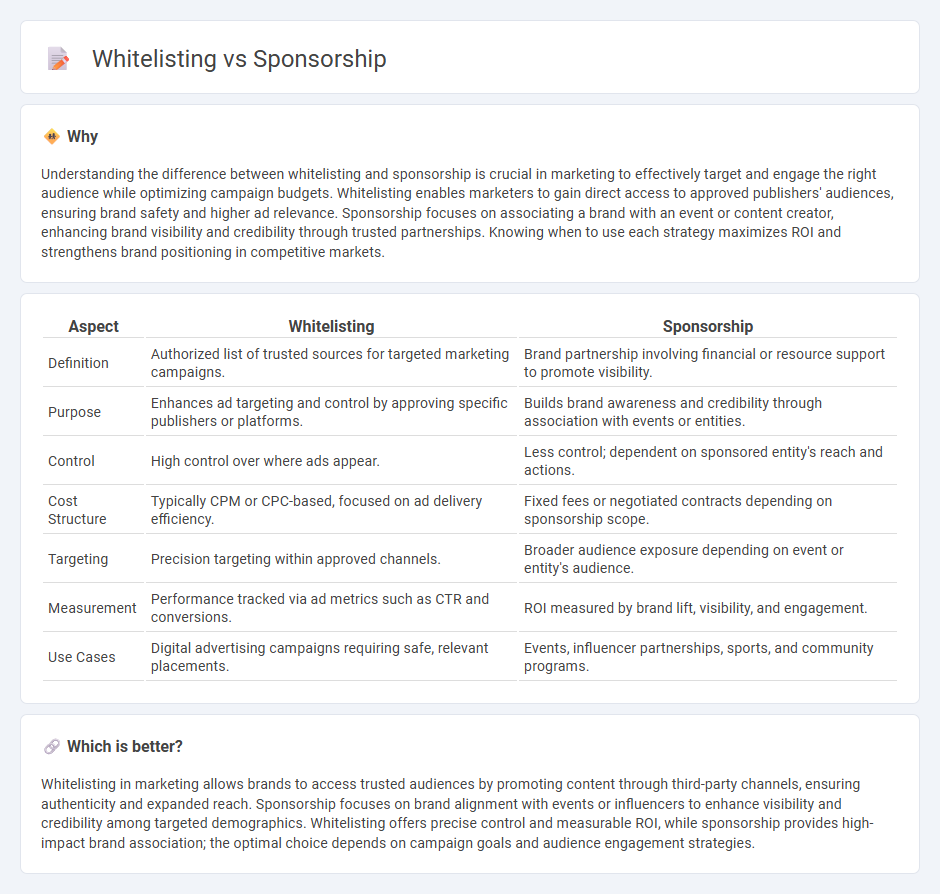
Whitelisting in marketing involves granting trusted advertising partners direct access to a brand's social media accounts for authentic content creation, enhancing campaign credibility and reach. Sponsorship focuses on funding events or influencers to promote brand visibility and align with target audience interests, boosting brand affinity and awareness. Discover how these strategies can elevate your marketing effectiveness and engagement.
Why it is important
Understanding the difference between whitelisting and sponsorship is crucial in marketing to effectively target and engage the right audience while optimizing campaign budgets. Whitelisting enables marketers to gain direct access to approved publishers' audiences, ensuring brand safety and higher ad relevance. Sponsorship focuses on associating a brand with an event or content creator, enhancing brand visibility and credibility through trusted partnerships. Knowing when to use each strategy maximizes ROI and strengthens brand positioning in competitive markets.
Comparison Table
| Aspect | Whitelisting | Sponsorship |
|---|---|---|
| Definition | Authorized list of trusted sources for targeted marketing campaigns. | Brand partnership involving financial or resource support to promote visibility. |
| Purpose | Enhances ad targeting and control by approving specific publishers or platforms. | Builds brand awareness and credibility through association with events or entities. |
| Control | High control over where ads appear. | Less control; dependent on sponsored entity's reach and actions. |
| Cost Structure | Typically CPM or CPC-based, focused on ad delivery efficiency. | Fixed fees or negotiated contracts depending on sponsorship scope. |
| Targeting | Precision targeting within approved channels. | Broader audience exposure depending on event or entity's audience. |
| Measurement | Performance tracked via ad metrics such as CTR and conversions. | ROI measured by brand lift, visibility, and engagement. |
| Use Cases | Digital advertising campaigns requiring safe, relevant placements. | Events, influencer partnerships, sports, and community programs. |
Which is better?
Whitelisting in marketing allows brands to access trusted audiences by promoting content through third-party channels, ensuring authenticity and expanded reach. Sponsorship focuses on brand alignment with events or influencers to enhance visibility and credibility among targeted demographics. Whitelisting offers precise control and measurable ROI, while sponsorship provides high-impact brand association; the optimal choice depends on campaign goals and audience engagement strategies.
Connection
Whitelisting in marketing involves approving specific advertisers or content to ensure brand safety and relevance, which enhances sponsorship effectiveness by targeting the right audience. Sponsorship leverages whitelisted platforms or publishers to maximize visibility and engagement without risking brand reputation. This strategic alignment ensures that sponsorship investments yield higher returns through precise audience targeting and trusted placements.
Key Terms
Brand Collaboration
Brand collaboration through sponsorship involves a company financially supporting an event, individual, or organization to enhance brand visibility and align with target audiences. Whitelisting in brand collaboration refers to granting permission for a partner to run paid ads on a brand's behalf, ensuring controlled and authentic messaging. Explore how choosing between sponsorship and whitelisting can optimize your brand partnerships and campaign effectiveness.
Content Control
Sponsorship allows brands to promote content while maintaining partial control over messaging and placement, ensuring alignment with brand values without full content ownership. Whitelisting grants advertisers complete control over the content by enabling them to distribute branded posts through third-party creators' channels, maximizing authenticity and reach. Explore the nuances between sponsorship and whitelisting to optimize your content control strategy effectively.
Audience Reach
Sponsorship enables brands to tap into the existing audience of an event or platform, offering high visibility through strategic placements and endorsements, thereby maximizing audience reach effectively. Whitelisting involves granting permission to advertise within trusted content or domains, targeting specific user groups while ensuring brand safety and enhanced engagement metrics. Discover how these approaches differ in driving audience expansion and choose the optimal strategy for your marketing goals.
Source and External Links
How to Get Sponsorships for Your Business - A sponsorship is when a corporation gives money or resources to a business or non-profit in exchange for promotion to that entity's customers, often forming a mutually beneficial brand exposure partnership.
What is sponsorship? | SPORTFIVE - Sponsorship is a business relationship where a company provides financial or material support to an event, person, or organization to achieve marketing goals and gain advertising and positive publicity.
How to Unlock Corporate Sponsorships: Get More Support - Corporate sponsorship involves companies funding nonprofit events or projects, offering support in forms like financial, in-kind donations, or media sponsorship to help both nonprofits and corporations benefit.
 dowidth.com
dowidth.com